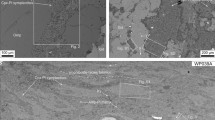Abstract
Polarized infrared (IR) spectra of olivine single crystals from 17 different localities show a tremendous variability in both mode and abundance of hydroxide (OH) incorporation. Kimberlitic olivines contain the most total OH at an estimated concentration level of 976 H/106Si, whereas olivines from basalts contain the least at 3 H/106Si. Olivines of metamorphic and hydrothermal origin have widely varying concentration levels intermediate between those of basalts and kimberlites. Over 30 distinct OH absorption bands have been identified. Most of these bands are not unique to individual localities but may be found in samples from several different localities. Pleochroism is consistent among localities, but relative band intensities vary. No evidence is found for molecular H2 in olivine.
Hydrous minerals have been identified in olivine by their characteristic OH absorption bands. Serpentine is commonly found and is clearly distinguishable from intrinsic OH. Talc is present in one sample. Prominent OH bands at 3572 and 3525 cm−1 are attributed to humite group minerals.
San Carlos, Arizona, olivines annealed in the presence of H2O develop absorption bands which are found in natural samples, however the OH absorption spectra of these annealed olivines are not identical to those of any single natural crystal. Sharp-band OH abundances in annealed samples are an order of magnitude lower than the maximum measured in natural specimens. The mechanical properties determined from these annealed olivines may not be directly applicable to mantle olivine because both the OH sites and concentrations are different.
Similar content being viewed by others
References
Aines RD (1984) The significance of infrared band shapes and positions in hydrogen bonded systems. PhD Thesis, California Institute of Technology, Pasadena, California, pp 57–87
Aines RD, Rossman GR (1985) The high temperature behavior of trace hydrous components in silicate minerals. Am Mineral 70:1169–1179
Bank H, Saul J (1972) Schleifwürdige Olivine aus Kenya. Z Dtsch Gemmol Ges 21:216–218
Beran A, Putnis A (1983) A model of the OH positions in olivine, derived from infrared-spectroscopic investigations. Phys Chem Minerals 9:57–60
Bragg WL, Claringbull GF (1965) The crystaline state, vol IV: Crystal structures of minerals. G Bell and Sons, London, pp 175–178
Brueckner HK (1977) A crustal origin for eclogites and a mantle origin for garnet peridotites: strontium isotopic evidence from clinopyroxenes. Contrib Mineral Petrol 60:1–15
Chopra P, Paterson MS (1984) The role of water in the deformation of dunite. J Geophys Res 89:7861–7876
Clocchiatti R, Massare D, Jehanno C (1981) Origine hydrothermale des olivines gemmes de l'île de Zabargad (St. Johns) Mer Rouge, par l'étude de leurs inclusions. Bull Minéral 104:354–360
Freund F, Oberheuser G (1986) Water dissolved in olivine: a single-crystal infrared study. J Geophys Res 91:745–761
Frey FA, Prinz M (1978) Ultramafic and mafic nodules from San Carlos, Arizona: Mineralogy, petrology and chemistry. Earth and Planetary Science Letters 38:129–176
Fujino K, Takéuchi Y (1978) Crystal chemistry of titanian chondrodite and titanian clinohumite of high-pressure origin. Am Mineral 63:535–543
Judd DB, Kelly KL (1976) Color — universal language and dictionary of names. National Bureau of Standards special publication 440, pp 184
Justice M, Graham E (1982) The effect of water on high-temperature deformation in olivine. Geophys Res Lett 9:1005–1008
Karato S, Paterson MS, FitzGerald JD (1986) Rheology of synthetic olivine aggregates: influence of grain size and water. J Geophys Res 91:8151–8176
Kats A (1962) Hydrogen in alpha quartz. Philips Res Rep 17:133–195
Keller PC, Fuquan W (1986) A survey of the gemstone resources of China. Gems and Gemology 22:3–13
Kirby SH (1983) Rheology of the lithosphere. Rev Geophys Space Phys 21:1458–1487
Kitamura M, Kondoh S, Morimoto N, Miller GH, Rossman GR, and Putnis A (1987) Planar OH-bearing defects in mantle olivine. Nature (in press)
Kohlstedt DL (1986) Role of point defects in high-temperature deformation of olivine. International Mineralogical Association, Fourteenth General Meeting, Stanford, California, Abstract: Abstracts with Programs, 143
Koivula JI (1981) San Carlos peridot. Gems and Gemology 17:205–214
Kronenberg AK, Kirby SH, Aines RD, Rossman GR (1986) Solubility and diffusional uptake of hydrogen in quartz at high water pressures: implications for hydrolytic weakening. J Geophys Res 91:12723–12744
Lacroix A (1922) Minéralogie de Madagascar. Tome I. Géologie minéralogie descriptive. Challamel A (ed), Paris, pp 79–83
Mackwell SJ, Kohlstedt DL, Paterson MS (1985) The role of water in the deformation of olivine single crystals. J Geophys Res 90:11319–11333
McGetchin TR, Silver LT, Chodos AA (1970) Titanoclinohumite: a possible mineralogical site for water in the upper mantle. J Geophys Res 75:255–259
Munsell book of Color (1976) Macbeth Division of Kollmorgen Corporation, Baltimore
Nakamoto K, Margoshes M, Rundle RE (1955) Stretching frequencies as a function of distances in hydrogen bonds. J Am Chem Soc 77:6480–6486
Paterson MS (1982) The determination of hydroxyl by infrared absorption in quartz, silicate glasses and similar materials. Bull Minéral 105:20–29
Ribbe PH (1982) The humite series and Mn-analogs. In: Ribbe PH (ed) Reviews in mineralogy, vol 5, ed 2, Orthosilicates. Mineralogic Society of America, Washington, DC, pp 213–274
Strens RGJ, Mao HK, Bell PM (1982) Quantitative spectra and optics of some meteoritic and terrestrial titanian clinopyroxenes. In: Saxena SK (ed) Advances in physical geochemistry. Springer Verlag, New York, pp 327–346
Suwa K, Yusa Y, Kishida N (1975) Petrology of peridotite nodules from Ndonyuo Olnchoro, Samburu district, central Kenya. Phys Chem Earth 9:273–286
Taylor WH, West J (1928) The crystal structure of the chondrodite series. Proc R Soc London Ser A 117:517–532
White TJ, Hyde BG (1982) Electron microscope study of the humite minerals: I. Mg-rich specimens. Phys Chem Minerals 8:55–63
Whitelock TK (1973) The Monastery Mine kimberlite pipe. In: Nixon PH (ed) Lesotho kimberlites. Lesotho National Development Corporation, Maseru, South Africa, pp 214–237
Wilson WE (1976) Saint John's Island, Egypt. Mineral Rec 7:310–314
Yamamoto K (1977) The crystal structure of hydroxylchondrodite. Acta Crystallogr B33:1481–1485
Author information
Authors and Affiliations
Additional information
Contribution number 4362
Rights and permissions
About this article
Cite this article
Miller, G.H., Rossman, G.R. & Harlow, G.E. The natural occurrence of hydroxide in olivine. Phys Chem Minerals 14, 461–472 (1987). https://doi.org/10.1007/BF00628824
Received:
Issue Date:
DOI: https://doi.org/10.1007/BF00628824




